Nearly every and any way you slice and dice it, one thing is clear: disclosure of and the rules surrounding law schools’ “median salary” figures for the Ministry of Human Resource Development (MHRD) National Institutional Ranking Framework (NIRF) need to improve.
First off, though, it should be said that NIRF’s ranking and the requirement that law schools all publish their submission on their own websites is already a huge step forward in assessing the quality of Indian law schools objectively, and will only become more so as more schools take part and the initial kinks get ironed out.
In the meantime, we have done quite a bit of number crunching at LI until our eyes bled, and to cut a long story short: Nalsar Hyderabad almost definitely made a mistake (at best), in overstating its median graduate salary to Rs 18 lakh per annum.
NLU Delhi’s disclosure of Rs 15 lakh also seemed on the high side, but could potentially be explained by a very narrow (but possibly disingenuous) reading of the NIRF rules, by only calculating the median from students who went through campus placements.
By contrast, NUJS Kolkata seemed to have been brutally honest with its stated median of only Rs 10 lakh per annum, probably by calculating a more realistic median from its entire batch of 128, rather than just from amongst its recruitment committee members (which would have probably resulted in a median closer to Rs 15 lakh).
However, NUJS should probably upload its NIRF submissions on its website quickly, before NIRF finds out (see below for details)...
The above findings alone would suggest that for the next edition of this ranking, NIRF should be clearer in specifying whether the median should be calculated from the entire graduating batch, or just from among those who participated in official campus recruitment activities.
At Legally India, of course, we have long advocated the latter approach, such as in our recruitment power rankings since any other methodology is very easy to manipulate and is not necessarily representative of average career opportunities that are available to law students.
The fuller analysis of NIRF median salaries follows below, starting with the self-disclosed median salary figures for the 2017 graduating batches submitted by each of the top 10 ranked law schools to NIRF.
Update 11:01: We have also added the median salary GMS score to the table below, which is calculated by NIRF and that accounts for 20% of the “graduation outcomes” score. This in turn accounts for 20% of the final score. In other words, the the median salary score contributes around 4% of the final score. Nalsar’s higher median salary is therefore unlikely to have made a difference in the final rankings.
| Median salaries | NIRF Median Salary (GMS score) | NIRF Graduation Outcomes Score | Total NIRF score | |
| NLSIU Bangalore | 14.5 | 24.82 | 77.78 | 75.79 |
| NLU Delhi | 15 | 23.17 | 62.52 | 74.58 |
| Nalsar Hyderabad | 18 | 25 | 89.53 | 70.95 |
| IIT Kharagpur | 8 | 18.38 | 71.46 | 67.07 |
| NLU Jodhpur | 14.5 | 23.73 | 75.53 | 63.5 |
| Jamia Islamia | 4.8 | 13.99 | 72.56 | 59.91 |
| NUJS | 10 | 21.24 | 63.12 | 59.17 |
| RMLNLU Lucknow | 9 | 19.54 | 79.04 | 54.82 |
| SLS Pune | 9.75 | 21.85 | 80.02 | 54.25 |
| Ambedkar | 1.968 | 15.16 | 56.02 | 50.93 |
Nalsar salary inflation
Of those, Nalsar Hyderabad stands out, with a median of Rs 18 lakhs, which is the highest among all the top 10 ranked law schools in the NIRF.
Reconstructing how Nalsar could have arrived at a median salary of Rs 18 lakh per annum is not easy, but we have provided full workings below if you’re mathematically inclined.
In short, unless all of the top law firms have secretly increased their salary packages from around Rs 15 lakh to Rs 18 lakh per annum, only for Nalsar students, Nalsar’s NIRF submission is arithmetically impossible.
We reached out to Nalsar vice chancellor (VC) Prof Faizan Mustafa last week, who said that recruitments and sharing information related to recruitments at the law school were “entirely student driven” and that he was unaware of the methodology the students would have used to submit the median salary.
Mustafa added: “The [Recruitment Coordination Committee] in the last two years has definitely done better than previous years, that I can definitely say.”
However, Nalsar assistant professor Sidharth Chauhan commented online below our previous story that first reported the NIRF rankings, in a personal capacity: “I inquired about this after the rankings were published earlier this week. Apparently, the replies to the NIRF questionnaire were prepared by our admissions office staff in September 2017. They simply mentioned one of the higher offers from domestic law firms (for the graduating class of 2017) instead of calculating the median salary.”
Chauhan added in the comment, again in a personal capacity: “It also appears that the replies to the questionnaire were not vetted by senior faculty members, which was done when we had applied for NAAC accreditation in January 2016. All in all, this is more a case of administrative shoddiness rather than deliberate falsification. Some of us did speak to the Vice-Chancellor and conveyed the need to take these rankings seriously, since it will be a mandatory exercise for public universities in the future. For starters, we need to provide accurate and updated information in response to the next round of NIRF questionnaires.”
It is probably fair to believe that Nalsar’s error was an honest one in this case. Because if it wasn’t, there are rather stiff consequence in the NIRF:
5.2 If it is found that an institution has deliberately manipulated the submitted data, causing erroneous rankings, NIRF will remove the institution from the ranking list and future rankings and publish a suitable note to this effect.
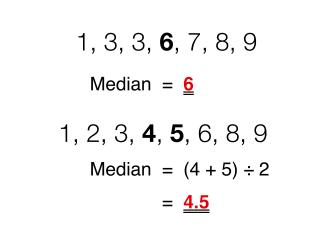
Medians and more at Nalsar
As a reminder in basic maths, the arithmetic median is different from the mean (which is more commonly referred to as the average). It can be a bit counterintuitive, but in short, it’s the value where an equal number of values are higher and lower (see graphic). It also effectively ignores all outliers (i.e., most unusually high and low values).
So, a median of Rs 18 lakh would presuppose that an equal number of students at Nalsar would have got job offers above Rs 18 lakh as got offers below Rs 18 lakh.
Considering that in our salary table tops out at around Rs 15 lakh (excluding foreign law firms), that seems unlikely.
Well, helpfully the NIRF rules require all participating institutions to publish source data on their websites.
Nalsar has done so for its 2018 NIRF participation, though that has no full breakdown of recruitment offers (it appears, judging by other submissions, that NIRF 2018 did not require a full breakdown of jobs and salaries offered).

However, fortunately the Nalsar website also contains its 2017 NIRF submissions, which give a breakdown of recruitments of how medians were calculated in previous years, which allows us to interpret at least 2015-16’s purported Rs 15 lakh median package figure.
That links to a spreadsheet with the following breakdown of 40 jobs:
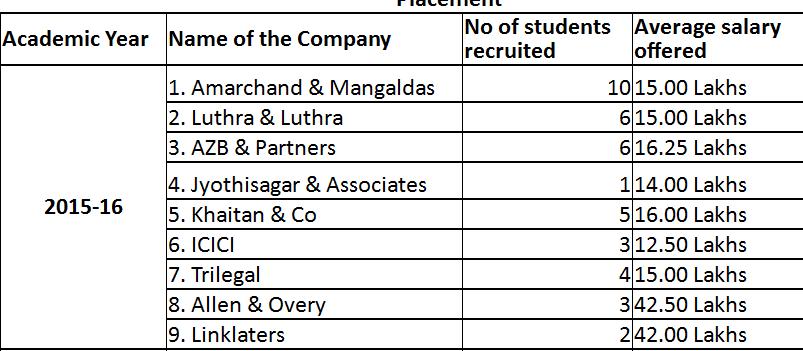
But, the good news for Nalsar is that at least the median packages of those 40 jobs, lo-and-behold, is indeed Rs 15 lakh. Also, the stated figures roughly correspond to our latest salary table of salaries (if you include possible maximum bonuses, which RCCs and law firms are keen to do).
You may wonder though: the total 2015-16 batch size was 78, according to Nalsar’s 2018 NIRF submissions, claiming that of those 68 students were placed, with 10 having selected higher studies. That leaves at least 28 unaccounted for in the figures presented.
But, the way the median works, even if you assume each of those 28 other jobs has a salary of only Rs 1, the median still works out to Rs 15 lakh.
Rs 18 lakh still seems impossible for any NLU
Nevertheless, we are still left with the problem of how Nalsar arrived at a 2017 batch median salary of Rs 18 lakh.
As far as we are aware, there has been no significant salary hike in the top tier of firms between 2016 and 17. As it stood in the last reported round of salary raises, only Talwar Thakore & Associates paid up to Rs 18.2 lakh per annum with a maximum bonus (from a base of Rs 13.2 lakh).
Other firms such as Trilegal, offer a base of Rs 13.2 lakh, with a bonus taking this up to Rs 15.4 lakh. Khaitan & Co’s maximum including bonus is Rs 16.2 lakh per annum, as is S&R Associates, while both Amarchands are at around Rs 15 lakh.
And while Nalsar’s 2017 recruitments that the student committee had disclosed to us at the time were definitely good, as usual, they were not significantly different from previous years.
We recorded 58 placed students, one more than Nalsar claimed in its NIRF submission.
Nalsar claimed that 21 students selected higher studies in 2017, that does not tally with what was disclosed to us at the time: we had reported that other than the 58 places students, 2 had secured LLM admissions, 4 would return to Bhutan to litigate or write public services exams, 7 would write civil or judicial services exams, 2 are planning to litigate, and 1 would join a business.
However, that’s a small niggle - even those 21 students on hypothetical salaries of Rs 1 each would not change the median from whatever it was otherwise.
The jury may be out on NLU Delhi’s Rs 15 lakh median package
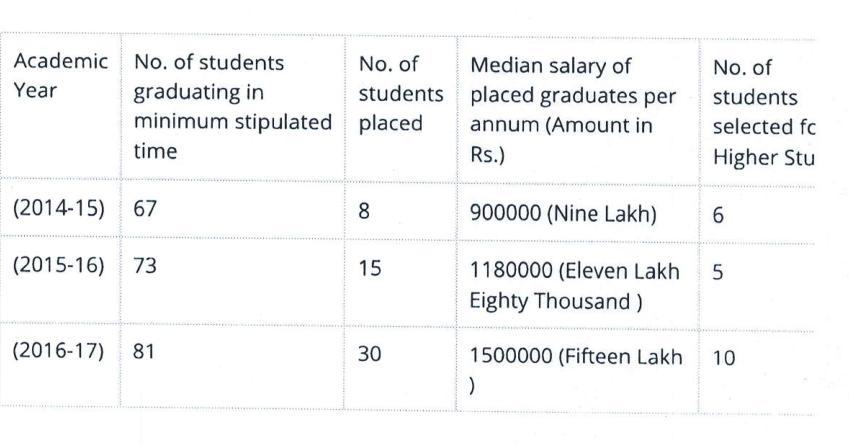
NLU Delhi had caused an upset of sorts by getting ranked second in NIRF, especially for those who have been going by traditional Common Law Admission Test (CLAT) preferences but ignoring the NLU Delhi’s controversial and bespoke All India Law Admissions Test (AILET).
In part that’s deserved, due to its strong faculty and relatively stronger performance in publications than perhaps all other NLUs.
However, NLU Delhi also quoted a median salary of Rs 15 lakh per annum in 2017 for 30 students that were placed out of 81 were placed.
It is realistically possible for the median to be 15 but only if calculating the median from 30 placed students rather than the entire batch of 81.
To be fair, this is a possible reading of NIRF’s table, which requires “median salary of placed graduates per annum”, but it could be interpreted as slightly disingenuous.
And since NLU Delhi had not shared with us its final 2017 recruitment breakdown, it is not possible to fully verify this figure right now (its Day Zero numbers we reported for the 2017 graduating batch suggested around 20 or so top-tier domestic law firm jobs and 3 foreign law firm vacation schemes).
Also, perhaps strangely, for 2018 NIRF NLU Delhi quoted a median salary for 2015-16 of Rs 11.8 lakh. But according to its 2017 NIRF submissions that also include a limited breakdown of 38 jobs offered, the median salary for 2015-16 between those would work out to Rs 13.8 lakh, for the top 38 jobs that had been disclosed by NLU Delhi in detail in its 2017 NIRF submission (see below).
Maybe it’s safe for the jury to still be out on NLU Delhi’s exact median.
We had contacted NLU Delhi VC Prof Ranbir Singh last week, who commented: “We have always been very transparent.”
Singh directed us to NLU Delhi registrar Prof GS Bajpai for further comment, but Bajpai has not yet responded with his comments since Friday despite promising to provide a breakdown over the weekend.
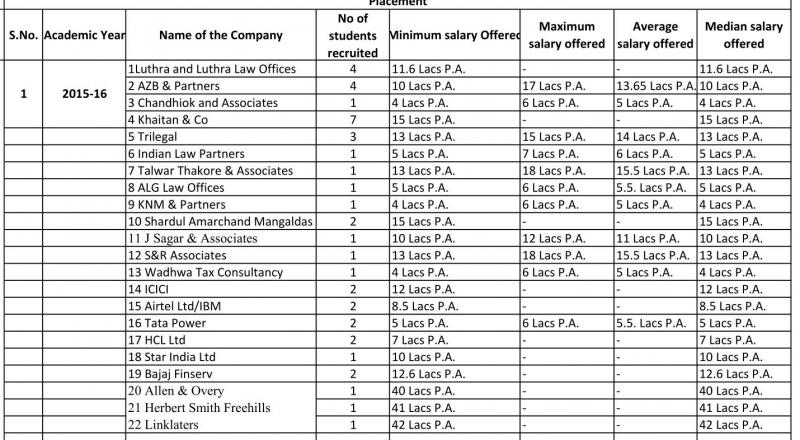
NLSIU Bangalore: Fairly close to expected
NLSIU’s uploaded NIRF form submission states median salaries of Rs 13.7 lakh in 2014-15 (before the last round of salary hikes kicked in), and Rs 14.5 lakh each in 2015-16 and 2016-17 (see below).
Considering what we’ve reported in the past, a median salary of Rs 14.5 lakh is not hard to believe. NLSIU Bangalore’s strong placements and what we have reported in the past.
(Worryingly, this has also highlighted a massive oversight on our part: we have not reported on NLSIU’s final campus recruitments results in several years! If the NLS RCC is reading this, please do share it).
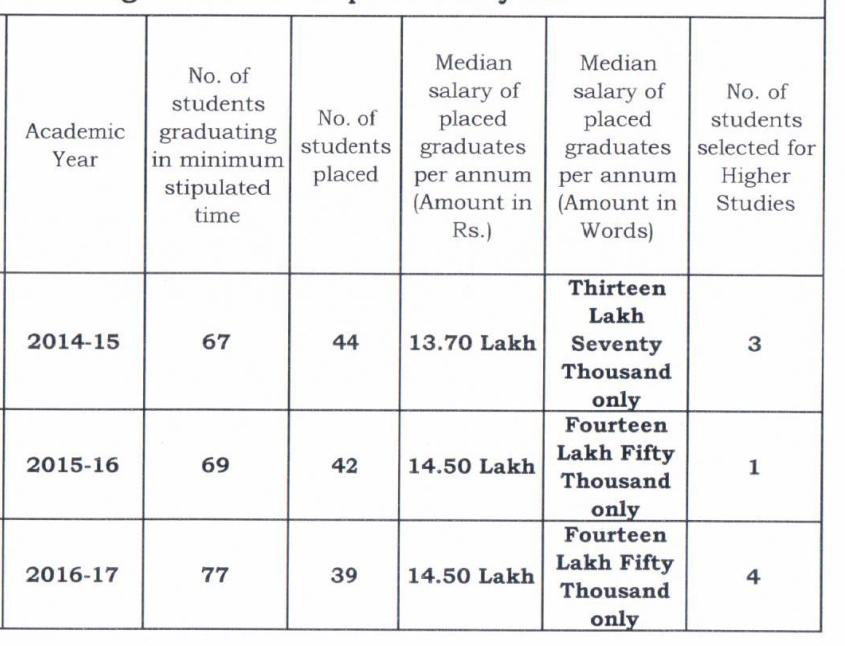
NUJS Kolkata: Well done, probably the only NLU to have been conservative in its median
NUJS Kolkata cited a median salary package of only Rs 10 lakh for NIRF.
In light of its large batch size of 128 students in 2017, that seems refreshingly honest compared to the others.
That said, NUJS Kolkata had one of the strongest final recruitments in 2017, with a ton of high paying corporate jobs for the vast majority of its 78 recruitment committee members.
Again, we haven’t run the detailed numbers, but it seems that with some massaging of the figures as others seem to have done, NUJS’ median could have also been similar to NLSIU, Nalsar or NLU Delhi at Rs 14.5 lakh (particularly if excluding those who did not participate in direct placements, as NLU Delhi seems to have done).
However, NUJS was also the only NLU whose NIRF source data we couldn’t find uploaded on its website (not surprising, since a long-standing gripe of students has been how the official website is woefully out of date).
This could potentially end up being a more serious problem, however, that could get NUJS pulled from the rankings if not remedied. According to the NIRF methodology:
3.3 Institutions who fail to post the data submitted to NIRF on their own websites as indicated in 3.2, may not be ranked. Thus, if the submitted data is not visible on the Institute’s own website prominently (NIRF will do a limited checking on a random basis), its registration for ranking is likely to be cancelled after an initial Notice. In case this fact comes to the notice of the NIRF after the rankings have been announced, the Institution will be taken out of the ranking list, with an appropriate noting.
NLU Jodhpur: Seems ok, and salaries have increased a fair bit since 2016
According to the information disclosed by NLU Jodhpur, median salaries have increased from Rs 11.5 lakh per annum in 2014-15, to Rs 12 lakh in 2015-16, and Rs 14.5 lakh per year in 2016-17.
NLU Jodhpur is fortunately one of the few colleges for which we have 2017 final recruitment figures.
Though we haven’t done the detailed math, at first glance, those recruitments seem to more or less stack up with a median maximum salary package of around Rs 14.5 lakh.
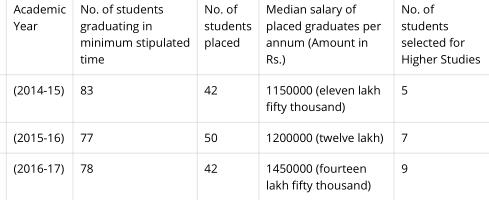
RMLNLU Lucknow
While we haven’t reported RMLNLU Lucknow’s recent final recruitment results, we may be inclined to believe its quoted median of Rs 9 lakh per annum.
Its self-published breakdown over the last 3 years below.
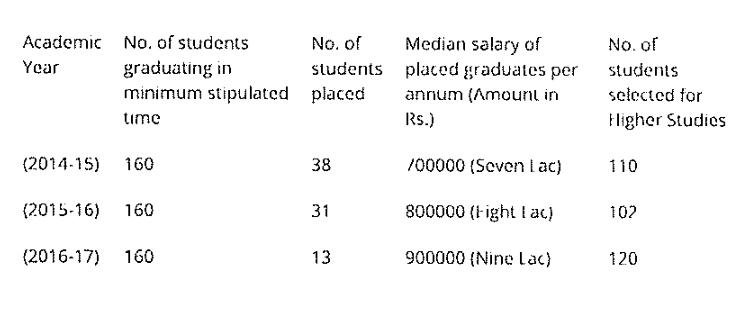
SLS Pune
Finally, we have never reported on SLS Pune’s graduate recruitments before and since no full break-down is available, we can’t really offer an analysis of these figures, but have included these for completeness since they are the only other ones above Rs 10 lakh in the NIRF’s top 10.
Placement of 239 out of 244 does seem on the high side, particularly at a self-disclosed median salary of Rs 11.5 lakh (up from Rs 10 lakh in 2014-16), but it is not necessarily impossible.
Can any SLS Pune students or alums shed some light on the accuracy of these?

threads most popular
thread most upvoted
comment newest
first oldest
first
And please also expose Jamia.
To be honest, I think you could argue that it was NIRF's fault that the rules were slightly vague on how to calculate the median, so it's quite possible to blame law schools' human error or misunderstandings, rather than outright malice or crookedness.
To my knowledge, the RCCs at NALSAR while disclosing the recruitment figures do not disclose the remuneration figures and I for one don't recollect the 2017 RCC doing anything different let alone stating the median remuneration figure as being 18 lakhs per annum.
Good on Prof. Chauhan's part to clarify instead of trying to pass the buck.
Kian, I think you should really reconsider having this comment moderated/removed. It serves no purpose other than being insulting and inflammatory.
But, as you say, they should have probably owned up and alerted NIRF to the error promptly once it became clear so it could be fixed - the NIRF methodology provides clear procedures for this.
I also agree, the comment above is borderline and probably a bit tongue in cheek intended to troll slightly (we have moderated comments with stronger language above), but technically publishing a wrong figure and not correcting it could be described as cheating, particularly when certain other law schools would disagree that Nalsar is second 'best' in the rankings.
From how I understand it, it doesn't matter if the lower 28 have a salary of Rs 1 or Rs 1 lakh or a mix of those, as long as there are at least 29 values that are Rs 15 lakh or higher.
I.e., with a distribution of 1, 1, 15, 15, 15, the median equals to 15.
With 1, 1, 15, 15, the median equals to 8 (i.e., the value in the middle between 1 and 15, if there is an equal number of 1s and 15s).
But mode would also produce some strange results and is a pain to calculate if you want a useful mode (you'd have to put all salaries into buckets of 1 or more lakhs in size, otherwise if CAM makes 20 offers to a law school at Rs 15.1512xyz lakh, the mode just ends up being Rs 15.1512x lakh, even if 100 other students get between Rs 1 and 100 rupees).
It's a more complicated and massive pain-in-the-ass model of calculation, where each job was put into one of 4 buckets or tiers, more or less depending on how much the job paid, which was then adjusted against the total batch size to account for underemployment in a batch or non-disclosure of figures.
www.legallyindia.com/201410315253/Law-schools/law-schools-recruitment-power-rankings-2013-14
www.sciencemag.org/news/2018/04/india-creates-unique-tiered-system-punish-plagiarism
Anyway, this year's Day Zero already gives it a median of at least 14.5 (if not more), and previous years were similar: www.legallyindia.com/lawschools/nls-after-day-zero-46-jobs-in-bag-already-out-of-76-grads-for-2019-trilegal-sam-cam-luthra-khaitan-biggest-recruiters-00011130-9287
At NLS, 46 out of 76 top tier jobs equals a median that is basically whatever the salary of those top tier jobs is: www.legallyindia.com/lawschools/nls-after-day-zero-46-jobs-in-bag-already-out-of-76-grads-for-2019-trilegal-sam-cam-luthra-khaitan-biggest-recruiters-00011130-9287
NLU Delhi Day Zeros of 16 top tier jobs for 78 graduates, is definitely not a median of Rs 15 lakh yet: www.legallyindia.com/lawschools/nlu-delhi-bags-16-jobs-for-78-grads-of-2019-00011130-9249
threads most popular
thread most upvoted
comment newest
first oldest
first